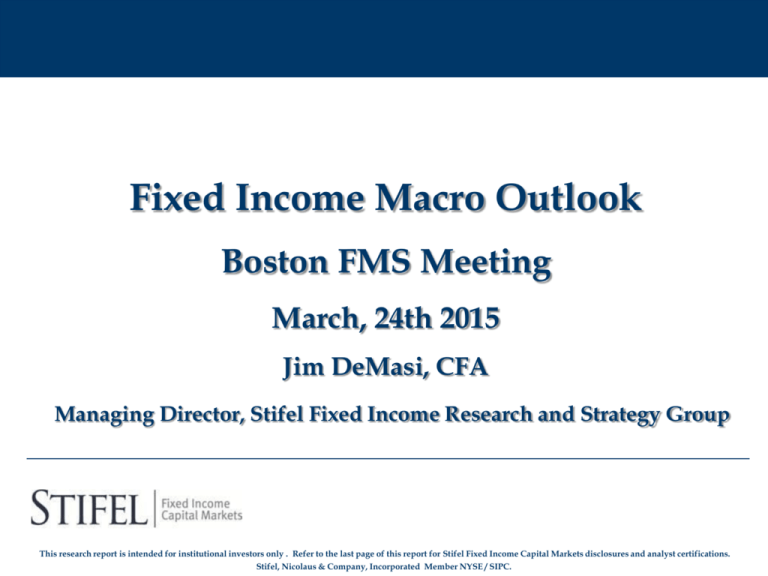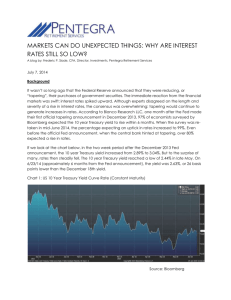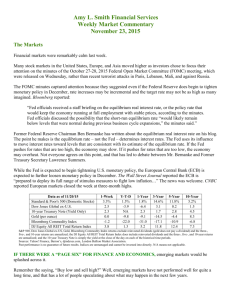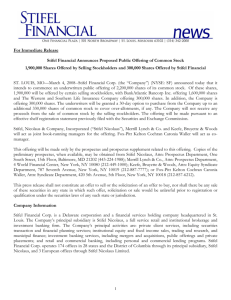
Fixed Income Macro Outlook
Boston FMS Meeting
March, 24th 2015
Jim DeMasi, CFA
Managing Director, Stifel Fixed Income Research and Strategy Group
This research report is intended for institutional investors only . Refer to the last page of this report for Stifel Fixed Income Capital Markets disclosures and analyst certifications.
0
Stifel, Nicolaus & Company, Incorporated Member NYSE / SIPC.
The Recovery from the Great Recession Remains a Work in Progress
($ in Billions)
17,000
(%)
Actual vs. Potential Real GDP
6.00
U.S. GDP Growth
GDP Avg. of 2.3% (3Q'09-4Q'14) GDP Avg. of 3.5% (1947-2007)
5.00
GDP Output Gap
16,000
4.00
15,000
3.00
14,000
2.00
13,000
Actual Real GDP
1.00
20-Year Pre-recession
GDP Trendline
(Potential GDP)
GDP QoQ
*Source: Bloomberg L.P. as of 12/31/2014
Nov-14
Jul-14
Mar-14
Nov-13
Jul-13
Mar-13
Dec-14
Apr-12
Aug-13
Dec-10
Apr-08
Aug-09
Dec-06
Aug-05
Apr-04
Dec-02
Aug-01
Apr-00
Dec-98
Apr-96
Aug-97
Dec-94
Aug-93
Apr-92
Dec-90
Aug-89
Apr-88
Dec-86
7,000
Nov-12
-3.00
Jul-12
8,000
Mar-12
-2.00
Nov-11
9,000
Jul-11
-1.00
Mar-11
10,000
Nov-10
0.00
Jul-10
11,000
Mar-10
12,000
GDP YoY
*Source: Bloomberg L.P. as of 12/31/14.
1
While falling energy prices and a strengthening job market have boosted
consumer spending, the economy is still not firing on all cylinders.
Consumer Spending
Business Investment
Core Retail Sales
YoY(%∆)
YoY(%∆)
New Orders and Inventories
8.0
7.00%
Nov-14
Jan-15
Jan-15
Jul-14
Sep-14
Mar-14
May-14
Jan-14
Nov-13
Jul-13
Sep-13
Mar-13
May-13
Jan-13
Nov-14
Residential Construction
Inventories
International Trade
New Housing Starts And Building
Permits
60.0
Nov-12
Jul-12
New Orders ex Transportation
*Source: U.S. Census Bureau as of 01/31/2015
*Source: U.S. Census Bureau as of 02/28/2015
**Core retail sales excludes autos & gas stations
YoY(%∆)
Sep-12
May-12
Jan-12
Jan-15
Sep-14
Nov-14
Jul-14
Mar-14
May-14
Jan-14
Sep-13
Nov-13
Jul-13
0.0
May-13
0.00%
Jan-13
1.0
Mar-13
1.00%
Nov-12
2.0
Jul-12
3.0
2.00%
Sep-12
3.00%
May-12
4.0
Jan-12
5.0
4.00%
Mar-12
6.0
5.00%
Mar-12
7.0
6.00%
YoY(%∆)
Exports
10.0
8.0
50.0
40.0
6.0
30.0
4.0
20.0
2.0
10.0
0.0
0.0
-2.0
-10.0
Building Permits
Sep-14
Jul-14
Mar-14
May-14
Jan-14
Nov-13
Sep-13
Jul-13
May-13
Mar-13
Jan-13
Nov-12
Sep-12
Jul-12
May-12
Jan-12
Jan-15
Nov-14
Sep-14
Jul-14
May-14
Mar-14
Jan-14
Nov-13
Sep-13
Jul-13
Mar-13
May-13
Jan-13
Nov-12
Sep-12
Jul-12
Mar-12
May-12
Jan-12
New Housing Starts
Mar-12
-4.0
-20.0
*Source: U.S. Census Bureau as of 01/31/2015
*Source: Bloomberg L.P. as of 02/28/2015
2
Positive Forces Supporting Continued Moderate Growth
Auto/Durable Goods Replacement Cycle
Housing Pent-Up Demand
Improving Household Balance Sheets
Disposable Income Growth
Job/Wage Growth in Professional Services, Technology, Education, and
Health Care Sectors
Revival in State and Local Government Spending
3
Missing Links to a More Robust Recovery
Pro-Growth Fiscal Policies and a Balanced Regulatory Regime
Stronger Global Economic Growth
Vibrant Labor Market Conditions
Normalized Housing Turnover Rates
Stable Financial Market Conditions
Pass-Through from the Financial Markets to the Real Economy
4
Labor Market Struggling to Regain Pre-Recession Dynamics
Labor Market Dashboard
Unemployment Rate
U6 Unemployment Rate
Annual Worker Wage Growth
Long-Term Unemployed (Millions)
Part-Time Seeking Full-Time Jobs (Millions)
Average Monthly Job Openings (Millions)
People Quitting Jobs, Monthly Avg. (Millions)
'03-'07
5.2%
9.0%
2.9%
1.54
4.44
3.96
2.75
Most Recent
5.5%
11.0%
2.0%
2.709
6.63
4.998
2.799
Difference from Pre-Crisis Avg.
+ 0.3 percentage points
+ 2.0 percentage points
- 0.9 percentage points
+ 75.91%
+ 49.32%
+ 26.21
+ 1.78%
*Source: Federal Reserve Board; Bureau of Labor Statistics; Bloomberg L.P. as of 03/16/2015.
5
Housing Turnover Remains Well Below Historical Levels
(000's)
2,500
New Home Sales
(000's)
Housing Starts
1,400
2,250
1,200
2,000
1,750
1,000
1,500
800
1,250
1,000
600
750
400
Housing Starts
20-Yr Pre-Recession Avg.
*Source: US Department of Commerce as of 02/28/15
Post-Recession Avg.
New Home Sales
20-Yr Pre-Recession Avg.
Nov-13
Apr-12
Sep-10
Feb-09
Jul-07
Dec-05
May-04
Oct-02
Mar-01
Aug-99
Jan-98
Jun-96
Nov-94
Apr-93
Sep-91
Feb-90
200
Jul-88
Dec-13
Jun-12
Dec-10
Jun-09
Dec-07
Jun-06
Dec-04
Jun-03
Dec-01
Jun-00
Dec-98
Jun-97
Dec-95
Jun-94
Dec-92
Jun-91
Dec-89
Jun-88
Dec-86
250
Dec-86
500
Post-Recession Avg.
*Source: US Department of Commerce as of 01/31/2015.
6
Financial Conditions Still Favorable But Volatility Increasing
Jan-15
Oct-14
Jul-14
Apr-14
Jan-14
Oct-13
Jul-13
Apr-13
All-time high of 2,117
set on 03/02/15
Jan-13
Oct-12
Jul-12
Apr-12
Oct-11
Jul-11
Apr-11
Jan-11
Oct-10
Jul-10
Apr-10
Jan-10
Jan-12
S&P 500 Index
2200
2100
2000
1900
1800
1700
1600
1500
1400
1300
1200
1100
1000
*Source: Bloomberg Finance L.P. as of 03/19/15
Financial Market Volatility
BofA MOVE Index (L-axis)
*Source: Bloomberg L.P as of 03/19/2015
Dec-14
Sep-14
Jun-14
Mar-14
Dec-13
Sep-13
Jun-13
Mar-13
Dec-12
Sep-12
Jun-12
Mar-12
Dec-11
Sep-11
Jun-11
Mar-11
50
45
40
35
30
25
20
15
10
Dec-10
120
110
100
90
80
70
60
50
40
VIX Index (R-axis)
7
GDP Growth Outlook
U.S. Real GDP Growth (%)
GDP Contributions by Sector
2010-2013
Household Consumption
1.6
Business Investment*
0.7
Residential Investment
0.2
Net Exports
0.0
Government Expenditures
-0.4
Real Final Sales
2.0
Inventories
0.3
Total (Average Annualized GDP Growth)
2.3
2014
1.9
0.8
0.1
-0.6
0.2
2.3
0.1
2.4
2015
2.2
0.7
0.2
-0.5
0.2
2.8
-0.3
2.5
Source: Bureau of Economic Analysis. 2015 is a Stifel projection. *Business investment includes structures, equipment, and intellectual property.
Positive Forces:
Disposable income growth
Stronger household balance sheets
Acceleration in consumer spending
Revitalization of housing market
Economic Challenges:
Stronger U. S. Dollar
Slower growth abroad
Negative consequences of lower oil and natural gas prices on U. S. energy industry
Heightened financial market volatility
8
Comparative Economic Forecasts
GDP
U. S. Economic Projections
Stifel FI Strategy Group Forecast
Bloomberg Economists' Survey
Fed Forecast - Central Tendency Mid-Point
Core PCE Price Index
Unemployment Rate (YE)
2014
2015
2014
2015
2014
2015
2.4%
2.4%
2.4%
2.5%
3.0%
2.5%
1.4%
1.4%
1.6%
1.4%
1.3%
1.4%
5.6%
5.6%
5.6%
5.3%
5.2%
5.1%
Updated as of 03/20/15.
While we envision a slight improvement in GDP growth this year, our
forecast is 0.5% below the Bloomberg consensus estimate.
Lower energy costs, weak global growth, and moderate wage gains should
keep core inflation well below the Fed’s 2.0% target level through the end
of 2015.
While unemployment should continue to fall, the rate of decline will likely
slow as previously discouraged workers return to the labor market.
The balance of risks to our forecast is tilted to the downside:
European deflation/contagion
Geo-political turmoil
Negative market reaction to Fed tightening
9
Interest Rate Outlook
Treasury Yield Curve
(%)
10-Yr B/E vs. Crude Oil Price
(%)
4.00
($)
2.4
2.3
2.2
2.1
2.0
1.9
1.8
1.7
1.6
1.5
10y
US Treasury Active Curve as of 03/19/2015
US Treasury Active Curve as of 12/31/2013
*Source: The Yield Book as of 03/19/2015
30y
10-Year Break-Even Rate (L-axis)
Feb-15
7y
Jan-15
5y
Dec-14
3y
Nov-14
2y
Oct-14
12m
Sep-14
6m
Aug-14
3m
40
Jul-14
0.00
50
Jun-14
0.50
60
May-14
1.00
70
Apr-14
1.50
80
Mar-14
2.00
90
Feb-14
2.50
100
Jan-14
3.00
110
Dec-13
3.50
Crude Oil (R-axis)
*Source: Bloomberg L.P. as of 03/19/2015
The vast majority the 1.0%+ decline in long-term Treasury yields since the beginning of 2014 can be
attributed to the sharp drop in inflation expectations .
Inflation expectations have rolled over primarily due to the plunge in oil prices. Other contributing
factors to the flatter Treasury curve include:
Low sovereign bond yields in other safe-haven countries.
Appreciation in the U. S. Dollar
Downward revisions to global GDP estimates
Heightened geopolitical risks
As oil prices have tentatively stabilized over the past few weeks, Treasury yields have leveled off.
10
Treasury yields are unlikely to increase significantly
until the Fed raises rates or inflation accelerates.
Over the past 20 years, the fiveyear Treasury yield has increased
by 100 bps or more over a 24month period on three separate
occasions. In all three cases, the
Fed was lifting short-term interest
rates during these periods of
rising Treasury yields. In every
other instance, the Treasury rate
spikes were temporary.
(%)
Fed Policy vs. 5-Year Treasury Yield
9.0
8.0
7.0
6.0
5.0
4.0
3.0
2.0
1.0
5-Year Treasury
*Source: Bloomberg L.P. as of 03/19/2015.
(%)
Core PCE (L-axis)
Jan-15
Aug-14
Mar-14
0.5
Oct-13
0.5
May-13
1.0
Dec-12
1.0
Jul-12
1.5
Feb-12
1.5
Sep-11
2.0
Apr-11
2.0
Nov-10
2.5
Jun-10
2.5
Jan-10
3.0
Aug-09
3.0
Mar-09
3.5
Oct-08
3.5
May-08
4.0
Dec-07
4.0
US Avg. Hourly Earnings (R-axis)
*Source: Bureau of Labor Statistics through February 2015.
11
Feb-15
Aug-13
May-14
Feb-12
Nov-12
Aug-10
May-11
Feb-09
Nov-09
Aug-07
May-08
Feb-06
Nov-06
Aug-04
Fed Funds Target Rate
Inflation vs. Wage Growth
(%)
Year-over-Year % Change
Moderate wage growth should
gradually pull the Core PCE Price
Index toward the Fed’s 2.0%
target rate over the next 12 to 24
months. Long-term Treasury
yields will likely remain relatively
stable as long as inflation is wellcontained.
May-05
Feb-03
Nov-03
Aug-01
May-02
Feb-00
Nov-00
Aug-98
May-99
Feb-97
Nov-97
Aug-95
May-96
Feb-94
Nov-94
May-93
0.0
Interest Rate Forecast
As disinflation works its way through the
economy, we expect the Fed to delay its initial
tightening move until the fourth quarter of
2015.
Projected Fed Timeline:
First Rate Hike: 4Q15
Terminal Funds Rate: 2.0% 4Q17
(%)
Fed Funds Projections
3.50
3.00
2.50
2.00
1.50
1.00
Fed funds should finish 2015 no higher than
0.50%, compared to consensus expectations for
a 0.75% year-end policy rate.
We expect the yield curve to continue to
flatten throughout 2015, as short-term yields
increase relative to long-term rates.
Long-term rates should remain well anchored,
even as shorter-term yields move higher.
Relative to the consensus projection of 2.58%,
we expect the 10-year Treasury yield to close
2015 at 2.25%.
0.50
Dec-17
Sep-17
Jun-17
Mar-17
Dec-16
Sep-16
Jun-16
Mar-16
Dec-15
0.00
Sep-15
Our projected path for the fed funds rate
closely resembles the forward curve but sits
well below the Fed’s “dot plot” forecast in
2016 and 2017. We expect the Fed’s path to be
downwardly revised again at the June FOMC
meeting.
Jun-15
Fed Funds Forward Rates Derived from Eurodollar Futures
Stifel Fed Funds Projections
Fed Dot Plot Median
*Source: Bloomberg L.P. as of 03/19/15
Yield Curve Projections
Fed Funds
2-year
5-year
10-year
30-year
2s to 10s
1Q15
2Q15
3Q15
4Q15
0.25%
0.25%
0.25%
0.50%
0.60%
0.80%
0.95%
1.15%
1.50%
1.55%
1.60%
1.70%
2.00%
2.10%
2.20%
2.25%
2.55%
2.65%
2.75%
2.80%
+140 bps +130 bps +125 bps +110 bps
*Updated March 10th, 2015
Source: Stifel Fixed Income Research and Strategy Group.
All projections are as of the end of the respective quarters.
12
Fixed Income Strategy Themes for 2015
Heightened interest rate and spread volatility
Increased importance of individual security selection
Barbell strategy outperformance as curve flattens
13
Bond Portfolio Strategies
Barbell Strategy Historical Total Returns
6.00
10
9
5.00
8
4.00
3.00
6
2.00
5
4
1.00
5-Year Treasury Yield
Quarterly Total Return
7
3
2
(1.00)
1
0
Mar-89
Feb-90
Jan-91
Dec-91
Nov-92
Oct-93
Sep-94
Aug-95
Jul-96
Jun-97
May-98
Apr-99
Mar-00
Feb-01
Jan-02
Dec-02
Nov-03
Oct-04
Sep-05
Aug-06
Jul-07
Jun-08
May-09
Apr-10
Mar-11
Feb-12
Jan-13
Dec-13
Nov-14
(2.00)
Barbell Quarterly Total Return
5 Year Treasury Yield
1.) Source: BAML Index Data, Stifel Calculations
2.) The barbell is a 3.2 average duration
combination of the 7 – 12 year Municipals Index
and the 1-3 year Tsy/Agcy Index
Barbell strategies with a 3-year average duration remain our preferred approach to position portfolios for further yield
curve flattening.
The long-term component of the barbell (10-years+) provides income protection and capital appreciation potential if
rates move sideways or decline further. Well-structured, call-protected securities such as Treasuries, Municipals,
Corporates, and CMBS are attractive candidates for the long-end of the barbell.
The short-term component of the barbell provides cash flow for reinvestment once short-term yields eventually rise and
helps to maintain overall portfolio duration and price sensitivity at reasonable levels. MBS, Agencies, ABS and CLOs
work well for the front-end of the barbell.
Our back-testing results in the table above show that a 3-year duration barbell would have produced a positive quarterly
total return 90% of the time over the past 25 years.
14
Depository Balance Sheet Strategies
With 2015 potentially representing a turning point for interest rates and the economy, regulatory focus is
likely to shift from Capital and Asset Quality to Interest Rate Risk (IRR).
As an example, the Winter 2014 edition of the FDIC’s Supervisory Insights focused almost exclusively on IRR.
While supervisors have pledged not to criticize institutions for “temporary adverse consequences to
earnings” coming from a IRR-driven repositioning, maintaining profitability is a key management focus.
Careful planning and consideration on both sides of the Balance Sheet should allow institutions to
effectively manage IRR without sacrificing profitability objectives.
Assets
Supplement organic loan demand with loan
Liabilities
Utilize interest rate derivatives such as swaps and
purchases and participations.
Evaluate non-core, credit-sensitive sectors in the
caps to manage IRR profile and funding cost.
“Blend & Extend” existing FHLB borrowings to
securities portfolio to enhance returns.
Utilize a barbell structure for portfolio composition.
Manage extension risk and price volatility via bond
swap opportunities.
Employ a variety of coupon rates, collateral types,
and cash flow structures.
lower rate and extend duration.
Utilize term borrowings vs. overnight.
Issue fixed rate debt and brokered CDs.
Pay up for longer time deposits.
Mitigate income-reducing transactions with
duration-matched leverage strategies.
15
Bond Market Total Returns by Sector
Description
US Broad Market Index
US Treasury
US Agency
Foreign Govt/Supra
Taxable Munis
Corporates
Financials
Industrials
Utilities
Mortgages
ABS
CMBS
Covered Bonds
High Yield Index
Municipal Bond Index
2014
2014
2015 YTD Total
Total Return (%) Excess Return (%)
Return (%)
6.27
6.02
4.06
5.41
18.79
7.51
6.13
7.73
11.60
6.07
1.63
4.33
2.31
2.50
9.78
0.31
0.05
0.64
0.67
2.88
-0.04
0.87
-0.56
0.44
0.74
0.55
1.57
0.75
-1.29
3.56
1.33
1.43
1.02
1.04
2.56
1.87
1.66
1.86
2.79
0.71
0.56
1.32
0.77
1.98
1.12
2015 YTD Excess
Return (%)
-0.03
-0.01
0.09
-0.12
0.01
0.25
0.40
0.13
0.71
-0.40
0.15
0.47
0.18
0.87
-0.02
Source: Bank of America Merrill Lynch as of 03/19/2015.
In contrast to last year’s robust performance, we expect the major investment-grade sectors to
produce low single-digit total returns in 2015.
Credit spreads have retraced approximately 50% of their October – January widening.
The municipal sector has the potential to repeat its top excess return ranking in 2015 .
16
Muni-to-Treasury Ratios
2-Yr ‘AAA’ Municipal as a % of 2-Yr UST
5-Yr ‘AAA’ Municipal as a % of 5-Yr UST
120%
100%
10 Yr Average = 87%
10 Yr Average = 97%
100%
80%
80%
60%
60%
20%
M-14
J-14
S-14
D-14
M-15
20%
M-14
J-14
S-14
D-14
M-15
30-Yr ‘AAA’ Municipal as a % of 30-Yr UST
10-Yr ‘AAA’ Municipal as a % of 10-Yr UST
110%
100%
Max = 92%
Min = 64%
Current = 82%
40%
Max = 108%
Min = 55%
Current = 79%
40%
120%
10 Yr Average = 93%
110%
10 Yr Average = 102%
90%
100%
80%
70%
60%
M-14
Max = 106%
Min = 83%
Current = 100%
J-14
90%
S-14
D-14
M-15
80%
M-14
Max = 114%
Min = 95%
Current = 109%
J-14
S-14
D-14
M-15
Source: Stifel, Bond Buyer
Source: Stifel, MMD; as of 3/19/15
17
Forecast Overview
Economy:
The U. S. economy should continue to expand at a moderate pace in 2015, with GDP
growth of 2.7%.
Consensus expectations for 2015 appear too optimistic and are vulnerable to downward
revisions.
Monetary Policy:
Monetary policy should remain highly accommodative for the next several years. The
first rate hike will likely be delayed until the fourth quarter of 2015 and could be pushed
into 2016.
QE has ended in the U. S., but the Fed’s $4+ trillion balance sheet and the ECB’s QE
program will likely suppress long-term bond yields for some time to come.
Treasury Yields:
Interest rates should fluctuate in well-defined trading ranges through at least the middle
of 2015.
During the second half of next year, the bond market will likely begin to anticipate Fed
rate hikes, which could trigger a more pronounced bear flattening trend.
Portfolio Strategies:
Achieving a reasonable balance between current income and future interest rate risk
remains the key to out-performance in this highly challenging low-yield environment.
18
Disclosures
Disclosures and Disclaimers
For distribution to institutional clients only
The Fixed Income Capital Markets trading area of Stifel, Nicolaus & Company, Incorporated may own debt securities of the borrower or borrowers mentioned in this report and may
make a market in the aforementioned securities as of the date of issuance of this research report.
Please visit the Research Page at www.stifel.com for the current research disclosures applicable to the companies mentioned in this publication that are within Stifel’s
coverage universe.
The information contained herein has been prepared from sources believed reliable but is not guaranteed by Stifel and is not a complete summary or statement of all
available data, nor is it to be construed as an offer to buy or sell any securities referred to herein. Opinions expressed are subject to change without notice and do not
take into account the particular investment objectives, financial situation or needs of investors. Employees of Stifel or its affiliates may, at times, release written or oral
commentary, technical analysis or trading strategies that differ from the opinions expressed within. No investments or services mentioned are available to “private
customers” in the European Economic Area or to anyone in Canada other than a “Designated Institution”. The employees involved in the preparation or the issuance of
this communication may have positions in the securities or options of the issuer/s discussed or recommended herein.
Stifel is a multi-disciplined financial services firm that regularly seeks investment banking assignments and compensation from issuers for services including, but not
limited to, acting as an underwriter in an offering or financial advisor in a merger or acquisition, or serving as a placement agent in private transactions. Moreover,
Stifel and its affiliates and their respective shareholders, directors, officers and/or employees, may from time to time have long or short positions in such securities or in
options or other derivative instruments based thereon.
Stifel Fixed Income Capital Markets research and strategy analysts (“FICM Analysts”) are not compensated directly or indirectly based on specific investment banking
services transactions with the borrower or borrowers mentioned in this report or on FICM Analyst specific recommendations or views (whether or not contained in this
or any other Stifel report), nor are FICM Analysts supervised by Stifel investment banking personnel; FICM Analysts receive compensation, however, based on the
profitability of both Stifel (which includes investment banking) and Stifel FICM. The views, if any, expressed by FICM Analysts herein accurately reflect their personal
professional views about subject securities and borrowers. For additional information on investment risks (including, but not limited to, market risks, credit ratings and
specific securities provisions), contact your Stifel financial advisor or salesperson.
Our investment rating system is three‐tiered, defined as follows:
Outperform ‐ For credit specific recommendations we expect the identified credit to outperform its sector
specific peers over the next six months.
Marketperform ‐ For credit specific recommendations we expect the identified credit to perform approximately
in line with its sector specific peers over the next six months.
Underperform ‐ For credit specific recommendations we expect the identified credit to underperform its sector
specific peers over the next six months.
Additional Information Is Available Upon Request
We, Jim DeMasi, CFA, Will Fisher, Kyle Cooke, and Marie Autphenne certify that the views expressed in this research report accurately reflect our personal views about the subject
securities or issuers; and we certify that no part of our compensation was, is, or will be directly or indirectly related to the specific recommendations or views contained in
this research report.
© 2015 Stifel, Nicolaus & Company, Incorporated, One South Street, Baltimore, MD 21202. All rights reserved.
.
19









